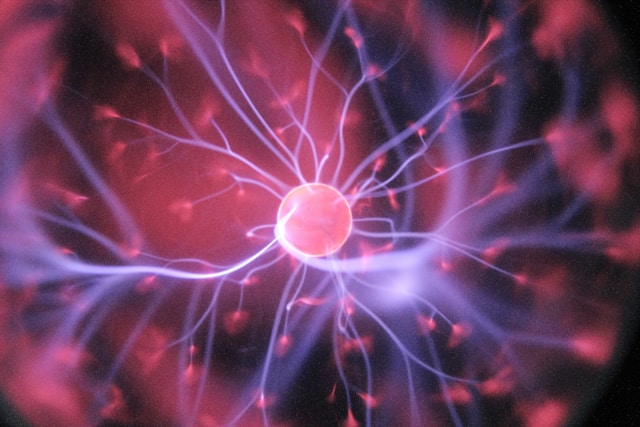Your mood, your well-being, and your motivation are no accidents. They are largely controlled by tiny chemical messengers in your brain – the neurotransmitters. These molecular communicators determine whether you feel energized or tired, happy or down, focused or distracted.
Particularly fascinating is the connection between amino acids and neurotransmitter synthesis. Your body uses these building blocks of proteins as the basis for producing dopamine, serotonin, GABA, and other important messengers. This means: what you eat and how you Amino acid balance optimizing can have a direct impact on your mental state.
The complex world of synaptic transmission
Communication between neurons takes place via highly specialized junctions called synapses. In these microscopic structures, information is transmitted from the presynaptic cell to the postsynaptic cell. When an electrically excitatory impulse reaches the presynaptic neuron, it can lead to the release of neurotransmitters from vesicles into the synaptic cleft. These messengers diffuse to the postsynaptic membrane and bind to specific receptors, which can open ion channels.
The central nervous system uses various transmitters such as acetylcholine, glutamate, and adrenaline to transmit both excitatory and inhibitory signals. While glutamate acts as the primary excitatory messenger, GABA as the main inhibitory transmitter can inhibit and modulate neuronal activity. This balance between excitation and inhibition is crucial for the normal function of the nervous system.
In motor neurons, transmission occurs at the neuromuscular junction, where acetylcholine as a transmitter can initiate the contraction of muscle cells. Disturbances in these processes can lead to various neurological diseases, including schizophrenia, where the balance of neurotransmitters in the brain may be impaired.
Exocytosis, the process of transmitter release, is a precisely regulated mechanism affecting both the peripheral and central nervous systems. Downstream neurons can be activated or inhibited by the binding of neurotransmitters to their receptors, enabling the complex information processing in our brain. These finely tuned processes at the synapses form the basis for all cognitive and motor functions and demonstrate how crucial the interplay of substances, membranes, and electrical signals is for our well-being.
Neurotransmitters 101: The Chemistry of Mood
Neurotransmitters are the currency of your nervous system. They transmit signals between nerve cells and thus determine how you feel and how your body functions. The four most important players in this complex system are:
Serotonin is considered the happiness neurotransmitter and regulates your mood, sleep, and feeling of satiety. A balanced serotonin level can contribute to more calmness and inner balance.
Dopamine is your motivation and reward system. It provides drive, focus, and the feeling of satisfaction after achieving goals. Dopamine's effect significantly influences your performance and perseverance.
GABA acts as a natural calming agent and dampens excessive nerve activity. It can help reduce stress and improve sleep quality.
Norepinephrine is your focus and energy neurotransmitter. It can sharpen your attention and help you stay productive even under stress.
The synthesis pathway from amino acids to neurotransmitters follows precise biochemical rules. Your body converts specific amino acids into the desired neurotransmitters using enzymes and cofactors. However, factors like stress, lack of sleep, unbalanced diet, or certain medications can disrupt this balance.
Serotonin: The Happiness Neurotransmitter
Tryptophan is the key amino acid for serotonin production. You can find this essential amino acid in protein-rich foods like turkey, salmon, eggs, pumpkin seeds, and bananas. Tryptophan can be taken as a supplement, but it competes with other amino acids for transport into the brain.
A more direct alternative is 5-HTP (5-Hydroxytryptophan), which is already one step closer to serotonin synthesis. Studies show, that 5-HTP can brighten mood and improve sleep quality. The optimal dosage is usually between 50-100 mg daily and can be mood-enhancing nutraceuticals are achieved.
Regarding timing: Tryptophan and 5-HTP should ideally be taken on an empty stomach, as they can better cross the blood-brain barrier this way. If you are already taking SSRIs (selective serotonin reuptake inhibitors), you should definitely seek medical advice before supplementation, as interactions may occur.
Dopamine: Motivation and reward system
For dopamine production, tyrosine and phenylalanine are the most important precursors. You can find these amino acids in almonds, avocados, bananas, and protein-rich foods. Tyrosine can be especially supportive under stress and high mental load.
A natural alternative to synthetic dopamine precursors is Mucuna Pruriens, a tropical plant that contains natural L-DOPA. L-DOPA is the most direct precursor of dopamine and can effectively enhance dopamine's effect.
However, balance is important: Too much dopamine stimulation can lead to restlessness, sleep problems, or even addiction-like behaviors. Therefore, moderate, cyclical use is advisable.
GABA: The natural calming agent
GABA supplementation is a double-edged sword. Pure GABA preparations can hardly cross the blood-brain barrier. It is more effective to support the body's own GABA production.
Theanine, an amino acid from green tea, can enhance GABA activity while promoting relaxed alertness. The optimal dosage is 100-200 mg daily.
Magnesium acts as a GABA receptor modulator and can enhance the calming effect. Taken as glycinate or bisglycinate, it can also improve sleep quality.
Taurine, a semi-essential amino acid, can also have a calming effect and facilitate the transition to sleep. Studies show that the combination of theanine, magnesium, and taurine can be especially effective for stress and sleep problems.
Norepinephrine: Focus and energy
Tyrosine is responsible not only for dopamine but also for norepinephrine and adrenaline synthesis. These neurotransmitters can improve your stress resistance and cognitive performance.
Studies show, that tyrosine supplementation can be particularly effective under stress conditions such as sleep deprivation, cold, or high mental strain. The optimal dosage is between 500-2000 mg daily.
Timing is crucial: Tyrosine should be taken in the morning on an empty stomach to ensure maximum energy and focus. In the evening, it can disrupt sleep.
The combination with Adaptogens like Rhodiola or Ashwagandha can additionally enhance the stress-resistant effect.
The gut-brain axis and neurotransmitters
A fascinating aspect of neurotransmitter regulation is the gut-brain axis. An astonishing 90% of serotonin is produced not in the brain but in the gut. Your gut flora plays a crucial role in neurotransmitter synthesis.
Certain bacterial strains can produce GABA, serotonin, and other neurotransmitters or promote their production. Probiotics, especially Lactobacillus and Bifidobacterium strains, can have a positive effect on mental health.
Prebiotics like inulin or resistant starch can nourish beneficial bacteria and thus indirectly support neurotransmitter production. A healthy gut can therefore be an important building block for mental well-being.
Synergistic combinations for optimal effect
The effect of amino acids can be enhanced by targeted combinations:
For serotonin support: Tryptophan or 5-HTP + vitamin B6 + magnesium can optimize serotonin synthesis and contribute to better mood and sleep quality.
For dopamine boost: Tyrosine + folate + vitamin B12 can promote dopamine production and increase motivation and focus.
For relaxation: Theanine + GABA + magnesium can have a synergistic calming effect and help with stress and tension.
Timing and dosing strategies vary individually. Generally, activating amino acids like tyrosine should be taken in the morning and calming ones like tryptophan in the evening.
Practical routine: Optimize mood with amino acids
A systematic approach can help you optimize your neurotransmitter balance:
Assessment: Observe your symptoms. Lack of motivation and drive can indicate low dopamine levels, while sleep problems and poor mood are often associated with serotonin deficiencies.
Morning protocol: Tyrosine (500-1000 mg) on an empty stomach for energy and focus.
Evening protocol: Tryptophan (500-1000 mg) or 5-HTP (50-100 mg) with magnesium (200-400 mg) for better sleep.
Cycle strategies: Do not use amino acids continuously but in cycles of 4-6 weeks with subsequent breaks.
Monitoring and consultation: Keep a mood and energy diary to document changes and share these insights with medical professionals.
Limits and safety instructions
Amino acids are not a cure-all. In cases of severe mood disorders or mental illnesses, they are often insufficient and cannot replace professional therapy.
Special caution is advised when combined with antidepressants. Tryptophan and 5-HTP can lead to a dangerous serotonin syndrome when combined with SSRIs.
Contraindications exist for various mental illnesses, pregnancy, and certain medications. Care by medical professionals is especially important in pre-existing conditions.
Conclusion
Amino acids can be used as natural mood supporters represent a valuable addition to your well-being. They offer a scientifically based approach to support your neurotransmitter balance and can contribute to more energy, better mood, and increased stress resistance.
Patience is important: Unlike synthetic medications, amino acids often require several weeks to exert their full effect. Realistic expectations and a systematic approach are the key to success.
The combination of targeted amino acid supplementation, healthy nutrition, and a balanced lifestyle can help you optimize your neurotransmitter balance and thus enhance your mental well-being.
FAQ
How long does it take for amino acids to work? The effect of amino acids on neurotransmitter production can vary individually. While some people notice changes after just a few days, others need 2-4 weeks for noticeable effects. Factors such as metabolism, diet, and baseline condition influence the speed of effect.
Can I take different amino acids at the same time? Basically, different amino acids can be combined, but they may compete for absorption. Activating amino acids like tyrosine should be taken in the morning, calming ones like tryptophan in the evening. Professional advice is advisable for complex combinations.
What side effects can occur with amino acid supplementation? Amino acids are generally well tolerated but can cause side effects if overdosed or used incorrectly. Possible effects include headaches, nausea, sleep disturbances, or increased blood pressure with tyrosine. Starting with low doses and gradually increasing minimizes the risk.
Legal notice regarding health-related claims:
Our information is for general informational purposes only and does not replace medical advice. Dietary supplements do not replace a balanced diet and a healthy lifestyle. Health-related claims about dietary supplements must comply with the Health Claims Regulation (EC) No. 1924/2006 and be approved by the European Food Safety Authority (EFSA). If you have health complaints or questions, please consult a doctor.












